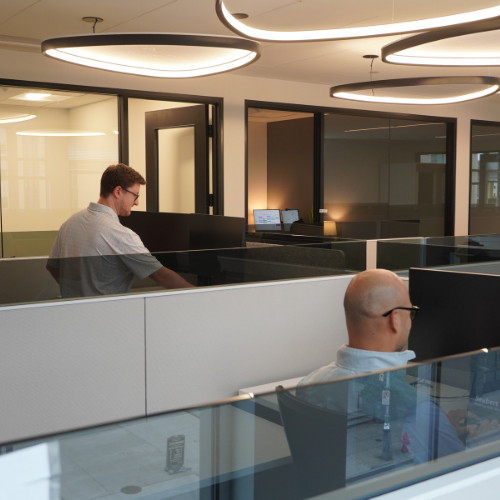
October is National Ergonomics Month—the perfect time to take a closer look at how your team works, moves, and feels throughout the day. While “ergonomics” might sound like a buzzword, it’s really about one thing: keeping people healthy, productive, and pain-free at work.
Whether your employees are at desks, on job sites, or on the road, small adjustments to posture, lifting technique, and workstation setup can make a big difference in comfort and injury prevention.
Why Ergonomics Matters
Even low-risk jobs can lead to aches and pains that develop into more serious injuries. Poor posture, repetitive movements, and awkward lifting techniques can contribute to musculoskeletal disorders conditions that affect muscles, nerves, tendons, joints, and cartilage.
Common problem areas include:
- Neck and shoulders from “tech neck” and slouching
- Lower back from improper lifting or sitting posture
- Wrists and hands from repetitive typing or gripping
- Eyes from poorly positioned monitors or glare
Over time, these issues don’t just cause discomfort—they can reduce focus, productivity, and morale. Addressing ergonomics is a proactive way to support employee well-being while reducing workers’ compensation claims and absenteeism. For more info, check out our webinar here
Posture Basics: Sitting, Standing & Moving Right
Good posture aligns the body so muscles, joints, and ligaments work efficiently with minimal strain. Encourage your team to:
When Sitting:
- Keep both feet flat on the floor (or on a footrest).
- Sit back with lumbar support maintaining the spine’s natural curve.
- Relax shoulders—avoid rounding forward or pulling too far back.
- Keep elbows close to the body, bent at 90°–120°.
- Switch positions often—stand or stretch every 30–60 minutes.
When Standing:
- Stand tall with shoulders back and core engaged.
- Keep weight balanced over the balls of the feet.
- Maintain head level—ears over shoulders, chin parallel to the floor.
- Avoid locking knees or leaning to one side.
When Moving:
- Take microbreaks to stretch hands, wrists, and neck.
- Shift tasks periodically to prevent repetitive strain.
Lifting Techniques that Protect Your Back
Improper lifting is one of the leading causes of workplace injuries—but it’s also one of the easiest to prevent.
Before lifting:
- Plan your route and clear obstacles.
- Test the object’s weight—get help if it’s too heavy or awkward.
During the lift:
- Stand close to the load with feet shoulder-width apart.
- Bend at the hips and knees, not at the waist.
- Keep your back straight, head up, and chest forward.
- Lift with your legs, not your back.
- Hold the object close to your body and avoid twisting.
When lowering:
- Reverse the lift—bend at the knees and hips.
- Set the object down slowly and carefully.
Remind employees that back belts don’t increase lifting capacity—proper form does.
How Employers Can Support Ergonomics
You don’t need a full-scale ergonomics department to make an impact. Start with these steps:
- Provide ergonomic chairs, adjustable desks, and footrests where possible.
- Offer quick ergonomic training or toolbox talks during safety meetings.
- Encourage open communication—let employees report discomfort early.
- Reinforce the value of posture awareness, especially in hybrid or remote settings.
- Celebrate Ergonomics Month with a short “Sit Smart, Stand Tall” challenge or posture check campaign.
At Seubert, we practice what we preach when it comes to ergonomics. Our offices are designed to support comfort, movement, and focus throughout the day. A few ways we help our team stay healthy include:
- Adjustable workstations that allow employees to alternate between sitting and standing.
- Ergonomic seating and equipment—from chairs with lumbar support to monitor risers and footrests.
- Wellness initiatives through our SELF program (Support | Educate | Live | Flourish) that promote stretching, posture awareness, and overall well-being.
- Offer interactive lunch and learns and educational events to build awareness and empower employees with ergonomic knowledge and
- Encouraging movement with walking challenges, stretch breaks, and friendly reminders to get up and reset posture throughout the day.
These small but intentional efforts help our team minimize strain, maximize focus, and create a healthier work environment.
The Bottom Line
Good ergonomics isn’t just about preventing pain—it’s about maximizing performance, focus, and energy.
When employees feel physically supported, they work smarter, safer, and stronger.
This October, take a moment to review how your workplace supports posture, movement, and comfort. Small changes today can create lasting health benefits for your team—and your business.
These tips are for general information and not a substitute for medical advice. Employees experiencing persistent pain should consult a healthcare professional.
References
Hospital for Special Surgery. (2023). Sitting posture tips for working from home. HSS. https://www.hss.edu/health-library/move-better/work-from-home-sitting-posture
Mayo Clinic. (2023, September 19). Office ergonomics: Your how-to guide. Mayo Clinic. https://www.mayoclinic.org/healthy-lifestyle/adult-health/in-depth/office-ergonomics/art-20046169
MedlinePlus. (2024, June 24). Guide to good posture. U.S. National Library of Medicine. https://medlineplus.gov/guidetogoodposture.html
Penn State Environmental Health and Safety. (n.d.). Ergonomics: Proper lifting techniques. Pennsylvania State University. https://ehs.psu.edu/sites/ehs/files/ergonomics_proper_lifting.pdf
Stanford Environmental Health & Safety. (n.d.). Postural awareness. Stanford University. https://ehs.stanford.edu/subtopic/postural-awareness
Stanford Environmental Health & Safety. (n.d.). Safe lifting techniques. Stanford University. https://ehs.stanford.edu/topic/ergonomics/safe-lifting
Towson University Environmental Health & Safety. (2024). Ergonomics guidelines for computer workstations. Towson University. https://www.towson.edu/public-safety/environmental-health-safety/documents/ergonomics-guidelines-for-computer-workstations-updated.pdf
University of North Carolina Environment, Health and Safety. (n.d.). Lifting and material handling ergonomics. UNC-Chapel Hill. https://ehs.unc.edu/topics/ergonomics/lifting-and-material-handling
University of Texas Health. (n.d.). Workstation ergonomics. UT Health. https://www.uth.edu/safety/ergonomics
U.S. Department of Labor, Occupational Safety and Health Administration. (n.d.). Computer workstations eTool. OSHA. https://www.osha.gov/etools/computer-workstations
U.S. Department of Health & Human Services, NIH Office of Research Services. (n.d.). Computer workstation ergonomics self-assessment checklist. National Institutes of Health. https://ors.od.nih.gov/sr/dohs/Documents/checklist-ergonomics-computer-workstation-self-assessment.pdf
 Christian Gabarda MS, MBA is Seubert’s Well-Being & Engagement Coordinator. Christian joined Seubert’s Employee Benefits Division in 2024 with over 13 years of professional experience. He helps clients enhance workforce well-being by developing tailored wellness programs, managing Seubert’s data analytics, building vendor relationships, and presenting data-driven strategies to clients.
Christian Gabarda MS, MBA is Seubert’s Well-Being & Engagement Coordinator. Christian joined Seubert’s Employee Benefits Division in 2024 with over 13 years of professional experience. He helps clients enhance workforce well-being by developing tailored wellness programs, managing Seubert’s data analytics, building vendor relationships, and presenting data-driven strategies to clients.
Contact Christian to see how you could minimize risk.
412.223.1433 | [email protected] | LinkedIn
- |
- |
- |
- |

